Faith and culture are complex balancing acts and there were many things in Pattani, that I didn’t enjoy or agree with. But the art and community I discovered there will stay with me for the rest of my life. It’s my hope that at Asia Art Tours we can bring you more of the incredible art of Asia and that art can help build bridges between faiths, cultures, and communities.
In 2019, Asia Art Tours will offer a tour of Pattani’s art and artists, I hope you’ll join us. We’ll have more information about the tour and Pattani in the upcoming weeks.

(Pattani’s central mosque, colloquially known as its Taj Mahal. An absolutely beautiful ode to the region’s faith.)
Part 1- History and Place
At Maiiam Gallery in Chiang Mai, the “rose” of northern Thailand , I first saw the painting of the woman in the Burqa. Like a suitcase dropping from my hands; for that moment my insecurities and selfishness were gone. In many trips to Thailand, I’ve met brilliant artists, whose work inspired me, but they always came from Bangkok and Chiang Mai. I had come to associate Thailand with Buddhism and the Thai ethnicity. This exhibition was from artists who came from Pattani, a region with a Malay and Muslim majority.
What was this place they called Pattani that was producing such incredible art?
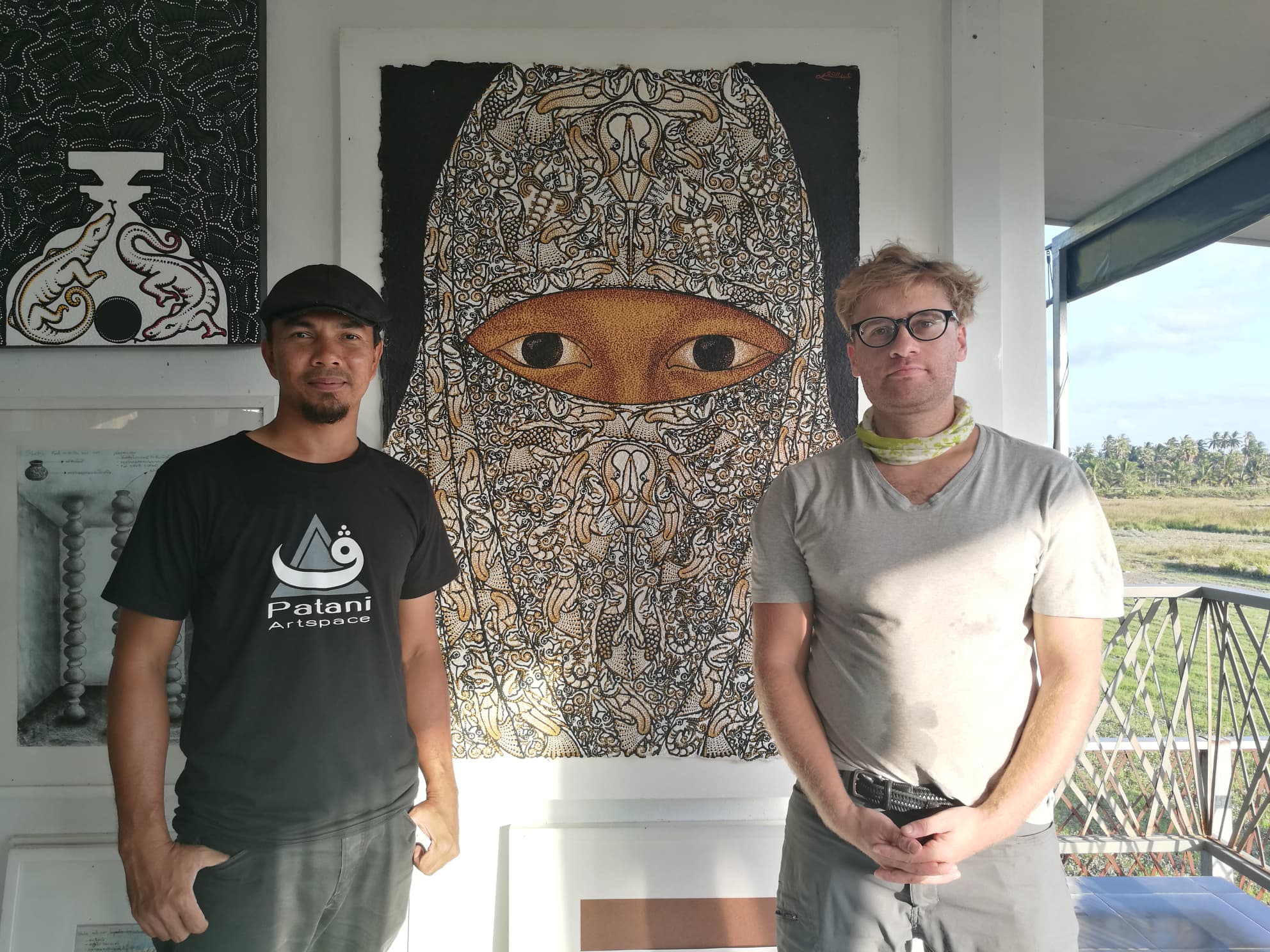
(Mr. Matthew Dagher-Margosian with Jehabdulloh Jehsorhoh in Pattani. He the artist featured with others in Chiang Mai and Maiiam. The interviews in this article discuss the differences and politics of Patani versus Pattani)
If Chiang Mai is Thailand’s rose, Pattani is its Bunga Mas tree, Made from gold and silver, Bunga Mas were symbolic gifts given (along with other riches) by the smaller southern kingdoms in tribute to the Thai Ayutthaya Kingdom under the Mandala patronage system. For most of its existence, Pattani was Patani, existing as an independent Islamic kingdom overseen by dynastic rulers. A multi-ethnic, multi-faith nation whose majority was Muslim and Malay. Overseeing Patani’s golden age from 1584 to the early 1700s were four Muslim queens, who welcomed Chinese and European traders to their ports. In awe of the prosperous, diverse and intellectual culture they called Patani the “cradle of Islam” in Southeast Asia.
Then in 1785, after several prior attempts, Patani was finally conquered and transitioned from a tributary state to part of the Siam Kingdom’s territory, who soon after divided it into several smaller territories. . . but this did not mean an end to its identity. Siam ruled mostly through relationships with local Muslim rulers it appointed but did not dictate to. Siam’s rule was often contested and any control over Patani was relatively abstract in the day-to-day faith or lives of its people. But Patani soon became a pawn in a much larger game, one that would change its delicate relationship with the Kingdom of Siam forever.
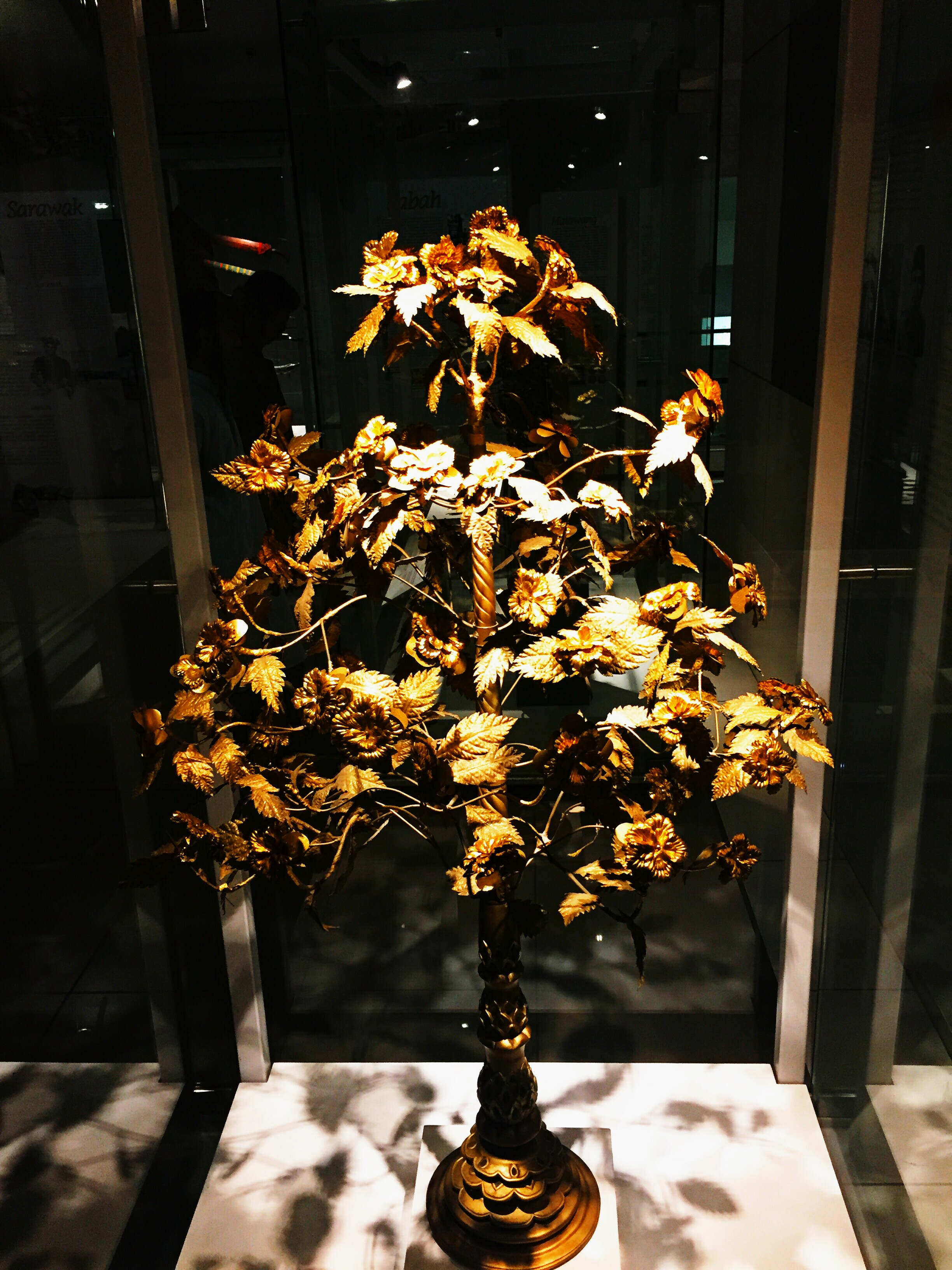
(A Bunga Mas Tree, these were given every 3 years by the Patani Kingdom to the Royal court of Siam as a tribute.)
In the late 1700s, Britain and France both doffed their powdered wigs, polished their guns and began threatening the Siam Kingdom, which by now was transitioning into a state and market economy. To keep these terrifying leviathans at bay, Siam needed to secure its borders or forever risk the European barbarians marching through their gates. Like an overstuffed goose, France’s imperial gluttony towards Siam was finally sated in 1907 after the Kingdom ceded what we now call Cambodia (having already given up much of present-day Laos in 1893). Then in 1909, Siam created its southern borders, by reached a treaty with the British, giving up control of all its territories in now present-day Malaysia, save for one: The center of Islam in southern Thailand, Patani.
For now, Patani’s past and Pattani’s present can’t converge. It was a Muslim kingdom, which today is part of a mostly Buddhist nation, its Malay majority a minority within the larger Thai State. Rather than these elements adding together to create something new, violence from both rebels seeking independence and the state demanding submission make for a brutal singularity: “Us” vs. “Them”, “Buddhist” vs. “Muslim”. Now, the path forward must overcome a tense situation where even a single “t” added or subtracted from the region’s name can incite violence.
Yet somehow, amidst blood and anger, Pattani produces some of the most dynamic art and activism in all of Southeast Asia. How is this possible?
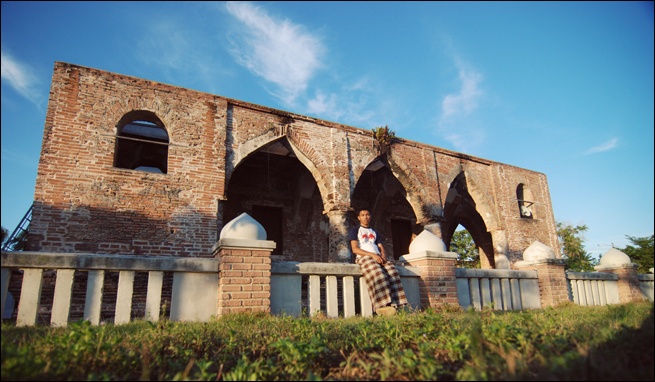
( Krue Se Mosque, Pattani’s oldest. The architecture is a mix of Islamic and European styles, reflecting Pattani’s cosmopolitan past)
I leave the show in Chiang Mai and spend the next several weeks sending emails to Thai artists and institutions. Some warn me not to go, that it’s too dangerous. Others are enthusiastic but have never dared to visit. Eventually, I connect with one of Bangkok’s most revered painters. He has not only been to Pattani, but painted its subjects extensively. He agrees to help connect me to the Pattani art community. But he also wants to know why take the risk when I can see the art safely in Bangkok or Chiang Mai galleries?
I say that to create art in Pattani is to go past ethnicity, faith, violence or the state to define ones’ own identity. It is constructing a defiant mirror whose reflections let you see yourself and others clearly for the first time. For a community in conflict, art genuinely may be a path forward to not just peace in a political sense, but also within the identity of Pattani’s inhabitants. To understand how Pattani was interacting with its art I needed to visit the community myself.
What I don’t say is that I’ve seen Bangkok and Chiang Mai’s best galleries. While the art is outstanding, its impact on the community far too often reminds me of Bunga Mas trees: Ornate bribes not meant for public consumption, given in praise and tribute to rulers far removed from the lives of their subjects. Secretly, I fear that if “high” art disappeared from both cities tomorrow, only the artists would care. The wealthy I’m sure would find new events at which to hold wine glasses and new ways to decorate their summer homes.
My fear of art being alienated from ordinary people is why I started my company, to reconnect the two. Right now, I think of “high” art viewed in a museum or gallery, the same way as a privately-funded skyscraper in a city, private property that imposes on rather than interacts with the public. Pattani might be able to show us a different way: where art is making the community and the community is making the art.
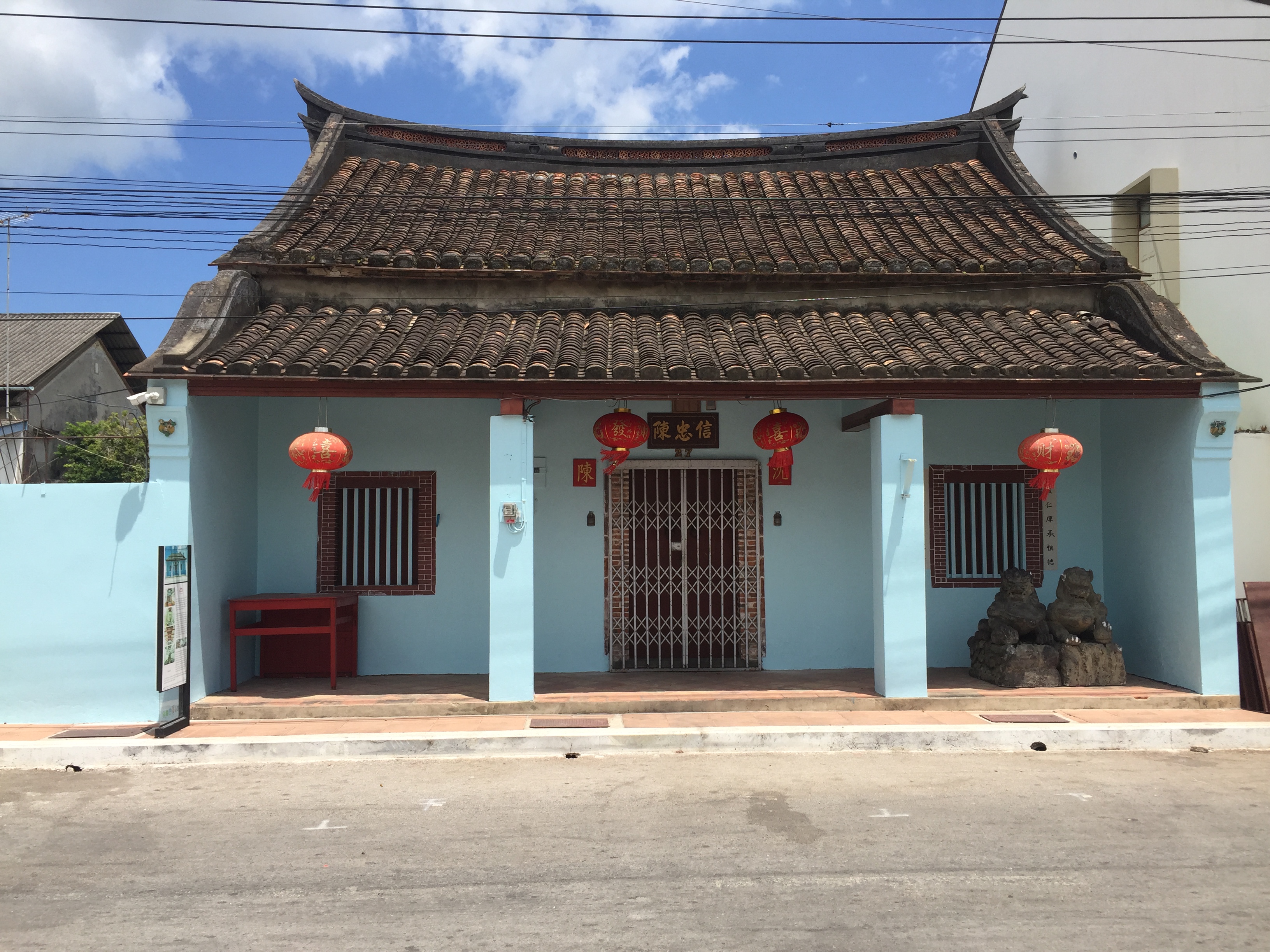
(Another remnant of Pattani’s cosmopolitan past: its Chinese community. There are still multiple homes in Pattani with similar features and a few elderly residents left from generations of Chinese families.)
The next morning, I exit Hat Yai Airport and board a dusty Toyota van bound for Pattani. The traffic signs directing us look like two serpents mating, as both Thai and Arabic script for Malay (Jawi) are featured. The road is lined with palm trees, minarets and the checkpoints of soldiers, the sun reflecting off their guns. I watch them stop two young men driving a pickup, and hear their body armor thumping against the car doors like a heartbeat. I close my eyes and drift off into a fitful sleep. When I open them next, I’m being dropped off in front of a concrete building, the Rainbow Hotel Pattani. I get a text to be ready in 5 minutes for pick-up to meet my first artist.
While I’m waiting in the hotel lobby, a young man saunters over with a strict smile. He has a thick beard and is wearing a Thawb, the long white robe popular in the Gulf States.
“My Friend. Where are you From?” he asks.
I tell him I’m from Michigan but live in Taiwan, he’s from here but works in Oman. We wish each other well and I’m smiling when I feel the hand on the back of my shoulder. My contact, still in her motorcycle helmet with the visor down, hands me a helmet of my own. Then we’re off, her hands on the throttle and my hands desperately gripping the seat as we race down Pattani’s streets.
(Pattani’s glory days as one of Southern Thailand’s busiest ports has come and gone. Still, a culture of sailing, boat-making, and cultural exchange remains).
On the road and in the open, the first thing I notice is that I’m being noticed. Unlike Bangkok where I’m but one cell in a teeming amoeba of American and European tourists, here I’m the only foreigner. The other motorbikes are mostly men, their wives riding on the back, in Burqas or Hijabs, some smile back and some glare. At every major intersection, there are soldiers, with M16 machine guns who stop drivers seemingly at random, neither side of the conversation being enjoyed by the other.
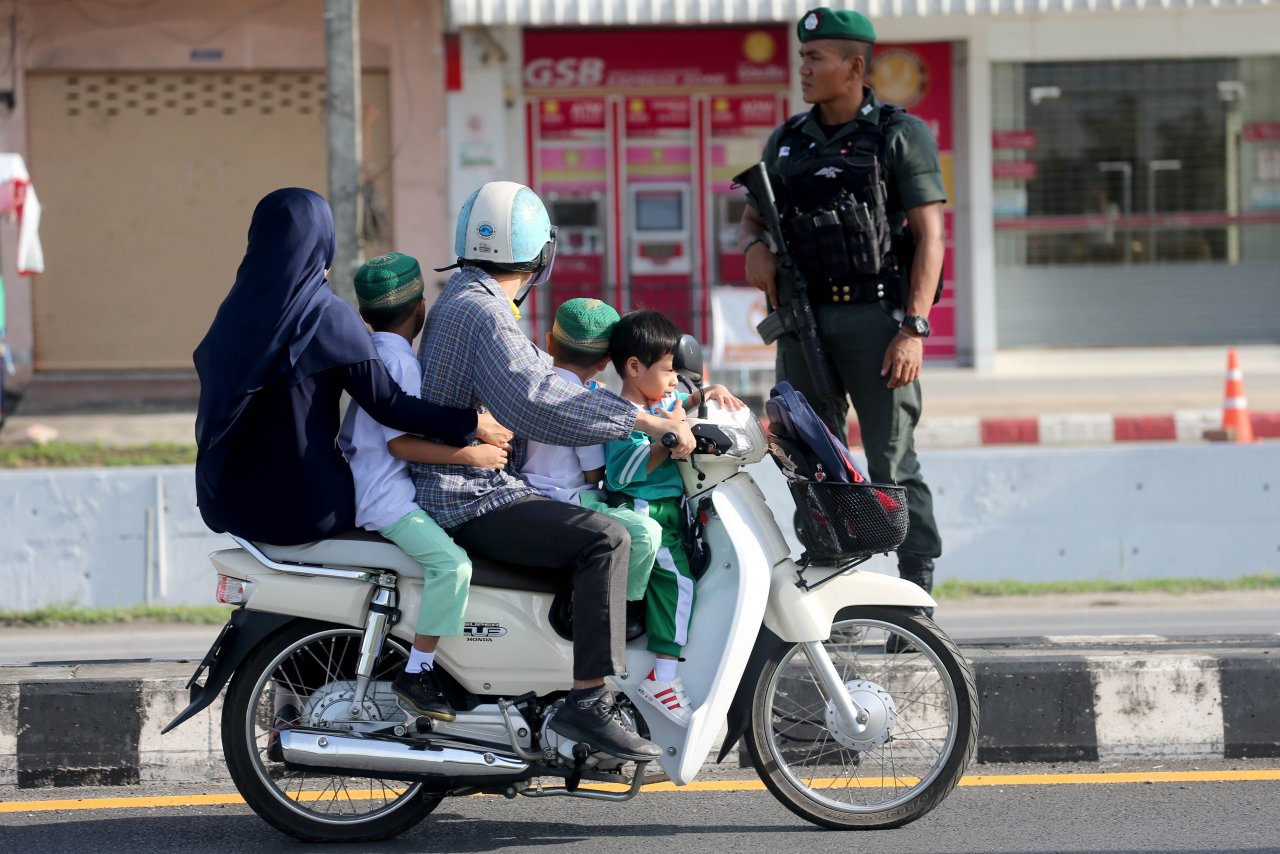
(A soldier on the road, throughout Pattani, there are multiple checkpoints at intersections that any suspicion person can be stopped at. What “suspicious means is open to interpretation.)
I close my eyes and feel the city’s tension. A troubling thought I’ve had since the start of my trip is that Pattani’s instability may be the fuel of its artists and their institutions. Suffering, anger, passion, these ingredients make up the lived terroir of many brilliant artists. Pattani’s dangers also keep out the tourism and art markets who would exploit what has been created here. It prevents entry from those who would again strip-mine its culture of precious resources after the centuries of pressure needed to create them. Then there’s me. How can I support and not exploit what has been built here?
Her moped stops and I hop off, we’ve arrived at our first art destination. Now, I’ll have to stop asking questions about Pattani, and answer what it poses to me. What reflection will I see, of the community and of myself in the canvas?
This is part one of our two-part series on Pattani, Thailand. In part two we will dive deep into the art and artists that make up its community.
To learn more about Pattani, the tours we offer there or the artists in its community, please contact Mr. Matthew Dagher-Margosian. You can reach me on Facebook, Instagram or by email at Matt@asiaarttours.com
For those interested in Pattani’s History, much of what I researched was from behind Academic Journal Paywalls, however this was one of the best summaries (even-handed and direct) as to the history and political situation of Pattani:
https://www.stabilityjournal.org/articles/10.5334/sta.bt/
as well as here: https://www.sipri.org/sites/default/files/files/PP/SIPRIPP20.pdf
and here: https://seap.einaudi.cornell.edu/sites/seap/files/MuslimThailand.pdf
